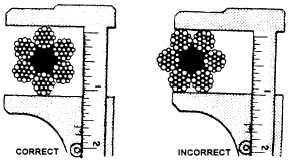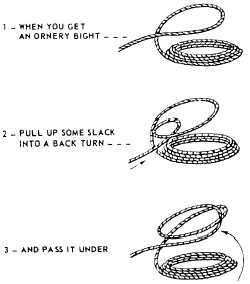Figure 13-7.-Correct and incorrect methods of measuring
wire rope.
at least 5 feet apart. Use the average of the three
measurements as the diameter of the rope.
NOTE: A crescent wrench can be used as an
expedient means to measure wire rope.
WIRE ROPE SAFE WORKING LOAD
The term safe working load (SWL) of wire rope
means the load that can be applied and still obtain the
most efficient service and also prolong the life of the
rope.
The formula for computing the SWL of a wire
rope is the diameter of the rope squared, multiplied by
8 (D x D x 8 = SWL in tons).
Example: The wire rope is 1/2 inch in diameter.
Compute the SWL for the rope.
The first step is to convert the 1/2 into decimal
number by dividing the bottom number of the fraction
into the top number of the fraction: ( 1 divided by 2 = .5).
Next, compute the SWL formula: (.5 x .5 x 8 = 2 tons).
The SWL of the 1/2-inch wire rope is 2 tons.
NOTE: Do NOT downgrade the SWL of wire rope
due to being old, worn, or in poor condition. Wire rope
in these conditions should be cut up and discarded.
WIRE ROPE FAILURE
Some of the common causes of wire rope failure are
the following:
l
l
l
l
size
l
Using incorrect size, construction, or grade
Dragging over obstacles
Lubricating improperly
Operating over sheaves and drums of inadequate
Overriding or crosr winding on drums
. Operating over sheaves and drums with
improperly fitted grooves or broken flanges
. Jumping off sheaves
l Exposing to acid or corrosive liquids or gases
. Using an improperly attached fitting
. Allowing grit to penetrate between the strands,
promoting internal wear
. Subjecting to severe or continuing overload
l Using an excessive fleet angle
HANDLING AND CARE OF WIRE ROPE
To render safe, dependable service over a maximum
period of time, you should take good care and upkeep
that is necessary to keep the wire rope in good condition.
Various ways of caring for and handling wire rope are
listed below.
Coiling and Uncoiling
Once a new reel has been opened, it maybe coiled
or faked down, like line, The proper direction of coiling
is counterclockwise for left lay wire rope and
clockwise for right lay wire rope. Because of the
general toughness and resilience of wire, it tends now
and then to resist being coiled down. When this occurs,
it is useless to fight the wire by forcing down the turn
because it will only spring up again. But if it is thrown
in a back turn, as shown in figure 13-8, it will lie down
properly. A wire rope, when faked down, will run right
Figure 13-8.—Throwing a back turn.
13-5



